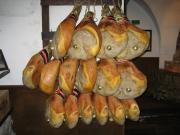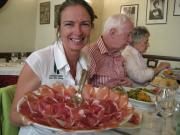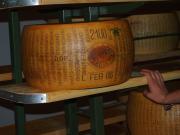Parma: City of Popes, Partisans, Prosciutto & Parmesan
Situated on the Western side of the region Emilia-Romagna, Parma is a prosperous and picturesque city which has given the world two of its greatest culinary inventions: Parma ham and Parmesan cheese. It is closely associated with the composer Giuseppe Verdi and has a busy calendar of musical, operatic and cultural events throughout the year. It is a compact city, easily navigable on foot, and strolling through its elegant streets and piazzas gives you the perfect opportunity to admire in the shop windows its bountiful displays of local produce.
Parma has a complex history – founded in 183 BC by the Romans it was an important town thanks to its strategic position on the Via Emilia. In the Byzantine period it was called Crisopoli and was later conquered by the Lombards. During this period new roads were built as well as the Parma stretch of the Via Francigena, Italy’s great Pilgrim route towards Rome.
It became a city republic in 1106 and the Cathedral and Baptistry were built during this time. The “signorie” who controlled the city and the territory of today’s province allied themselves to the Holy Roman Empire, against the Papacy.
However, things changed in 1545 when Parma became the capital of the Duchy of Parma and Piacenza, ruled by the Farnese family. The most important member of this powerful family was Pope Paul III. In this period important landmarks were built such as the Palazzo della Pilotta, S. Giovanni Evangelista, Madonna della Steccata, and flourishing painting schools were founded, most notably those of the artists Correggio and Parmigianino.
In the second half of the 1700s with the Bourbon reign, there was a second period of flourishing artistic and cultural activity with a considerable French influence. The Duchy was subsequently passed in 1816 to Maria Luigia of Austria, the wife of Napoleon. On the duchess’s death, power reverted to the Bourbons, but almost immediately the Duchy became part of the provinces of Carlo Farini’s Emilia. In 1860 it was finally annexed to Piedmont and consequently to the unified Kingdom of Italy.
During the second world war, Parma was a strong centre of Partisan resistance. Areas close the station, including much of the Palazzo della Pilotta, were destroyed by allied bombing raids but the city was finally liberated from German occupation in April 1945.
Today Parma has a population of around 180,000 people and is an attractive and elegant city. You cannot fail to be impressed by its gastronomic traditions – not just the world-famous Prosciutto ham and Parmesan cheese but also Culatello – fillet of pig’s thigh – aged for about a year with a delicious melting texture.



We would highly recommend Parma to anyone travelling in Italy this summer and we have much more useful logistical information on ourParma city page.
Finally we would like to say that, in response to the two recent earthquakes which have struck parts of Emilia-Romagna closer to Bologna, we have donated the sum of €320 to the Italian Red Cross, to assist with the emergency programmes following the destruction caused by the tremors. This represents €20 for each person on our Parma, Tuscany & Cinque Terre tour running in September. If anyone would like to make a donation, this can be done easily through the Italian Red Cross website.
The photos show the Duomo, the Baptistry, the Palazzo della Pilotta, Giuseppe Verdi, Correggio’s Assumption of the Virgin in the dome of the cathedral, the Partisan Monument, Prosciutto and Parmesan. (And Jackie!)
